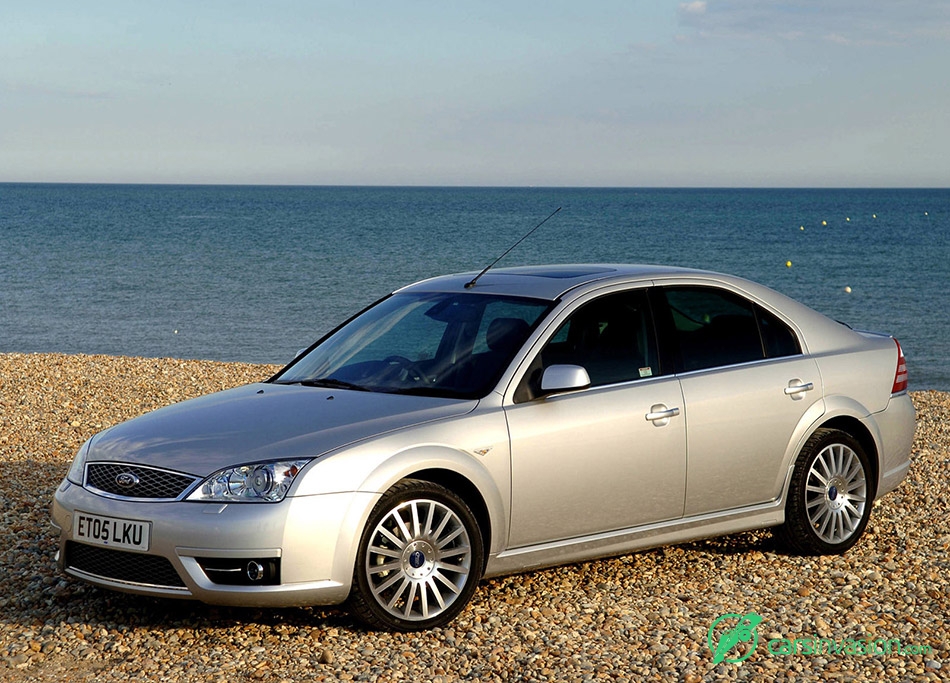Launched in October 2000, the Mondeo Mk III was considerably larger than its predecessor, but is still based on the Mk I's floorpan and running gear. Although Ford abandoned its New Edge design theme for the Mondeo Mk III, it still borrowed some styling cues from the Focus Mk I, giving it an overall effect which many critics felt was more restrained and mature than the Focus if much less distinctive. Two of the old car's biggest weaknesses, the modest rear legroom and uncompetitive diesel version were addressed by a longer wheelbase and the new "Duratorq" diesel engine.
Following the standard setting interior of the Volkswagen Passat Mk IV in 1996, Ford paid a great deal of attention to the Mk III's interior and was the first mainstream manufacturer to react to the new standard set by Volkswagen. Ford dispensed with the rounded American style interior of the Mk I and developed a more sober 'Germanic' design which not only seemed more sophisticated but, more importantly, was of a higher quality due to the use of more expensive materials and was much nicer than any German manufacurer had to offer.
As with its predecessor, passive safety was a major selling point of the 2000 Mondeo. With an even stronger bodyshell, Ford introduced its so-called "Intelligent Protection System" (IPS), which used an "intelligent" array of sensors based on a neural network to decide the best combination of safety devices (traditional front passenger airbags, side airbags and curtain airbags) to deploy for a given crash situation. To enhance active safety, all models were fitted with anti-lock brakes and electronic brake distribution, with electronic stability program (ESP) available as an option.
Engines
For the Mk III, the 1.6 L Zetec engine was dropped while the 1.8 and 2.0 L engines were heavily revised and were renamed Duratec. The standard 2.5 L V6 engine was carried over, while a 3.0 L version was developed for the ST220 model.
The archaic Endura-E 1.8 L turbodiesel engine was dropped and replaced by a more sophisticated 2.0 L Duratorq direct-injection (TDCi) unit with a variable geometry turbine. This clever turbine system allows a certain amount of overboost, giving an extra 10% or so of torque for short periods. This engine, known within Ford as the "Puma"-type Duratorq, was first seen in the Transit in detuned form.
A new automatic transmission was added to the range called the Durashift. This unit has five gears and may be shifted manually or shifted like an automatic.
For 2004, the Mondeo was given a very mild upgrade, the new models being identifiable by the larger chrome honeycomb grille, a new central dashboard made from higher quality materials with electronic climate control, either a standard Ford radio, Sony radio or a satellite navigation radio/CD player which also has climate control built into the unit in lieu of the space taken up by the unit. The Durashift automatic is now available with steering wheel control, while a 96 kW (130 PS) common rail version of the Duratorq turbodiesel engine became available. The gasoline engines were revised at this stage also — the new SCI (direct-injection) version of the 1.8 L Duratec engine was introduced which generates 4 kW (5 PS) more than the standard unit. In addition, equipment was upgraded across the range — with cruise control and a trip computer now standard on all models.
In 2005, there were two new Duratorq direct-injection (TDCi) options, a 2.2L with 114 kW (155 PS) and a detuned version of the 2.0L with 65 kW (89 PS). Also, the Seat Belt Warning System was added and is now standard, with an audible/visual warning signal reminding the driver to fasten his/her seat belt. The styling was upgraded again, the most notable difference being tweaked taillights.
Source: Ford














